by H. F. Schwartz* (3/13)
Quick Facts…
 |
Figure 1: Smut lesions on leaf and stem tissues. |
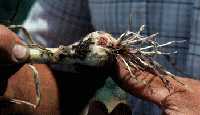 |
Figure 2: Pink root symptoms. |
- Common soil-borne diseases of onion in this region are seedling damping-off, pink root and fusarium basal rot. Other soil-borne organisms include nematodes, smut and insects.
- Damping-off, fusarium basal rot and pink root are favored by moderate to high soil temperature, frequent cropping to onions, soil compaction, poor drainage, cultivation wounds and low soil fertility.
- The pathogens involved survive for years in infected debris and infested soil.
Colorado is a major producer of onions. Approximately 7,500 acres are planted annually on the Western Slope, in the Arkansas Valley and throughout northeastern Colorado. Yields often average 400 hundredweight per acre unless constraints, such as soil-borne diseases, become widespread and serious enough to limit production. Plant survival, bulb size and quality can be reduced and thereby affect crop productivity (up to 60 percent yield loss recorded) and profitability. Soil-borne disease problems of seeded and transplanted onions include: damping-off, pink root, fusarium basal or plate rot, bloat or stem and bulb nematode, and smut.
Pathogen Survival
Soil-borne fungal pathogens and nematodes can persist for many years in previously infected onions or other host debris and infested soil by producing overwintering structures or entering resting phases. These structures may be thick-walled spores (Pythium oospores, smut teliospores, and Fusarium conidia or chlamydospores) and hyphae (fungal threads of Rhizoctonia and fusarium), or small dark structures such as microsclerotia (Rhizoctonia) and pycnidia (pink root). Preadult nematode larvae can become quiescent (resting phase) on basal plates of dried bulbs or on seed. Many fungal pathogens also can survive on or in seed. Short-term survival of these pathogens is common in roots and other structures of
contaminated transplants.
Overwintering pathogens may be stimulated to germinate by various factors including plant exudates from developing, susceptible tissue such as onion roots. Dormant pathogens also may be stimulated to germinate harmlessly by non-host roots or to maintain and reproduce themselves until susceptible plant tissue again becomes available. The numbers of survival structures per unit of soil (inoculum densities) of these soil-borne pathogens can be reduced by organisms (other
types of fungi and bacteria) that are antagonistic, and by factors described in the disease management section of this fact sheet.
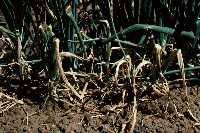 |
Figure 3: Foliage symptoms of fusarium. |
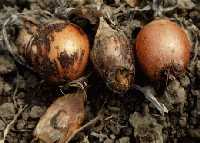 |
Figure 4: Advanced symptoms of fusarium and pink root at harvest. |
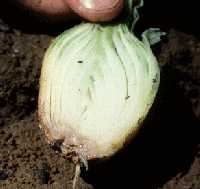 |
Figure 5: Fusarium-rotted basal plate and root system. |
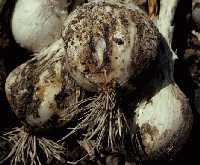 |
Figure 6: Misshapen bulbs (bloat) and splitting caused by nematodes. |
Disease Development
The incidence and severity of these soil-borne organisms and the diseases they cause are affected by many environmental, host and cultural factors. The factors shown in Table 1 individually, and often collectively, aggravate soil-borne disease development as plant stress increases.
Disease Symptoms
Damping-off (caused by Pythium, Fusarium and Rhizoctonia species) may appear in circular to irregular shaped areas
within fields, or on individual plants between healthy appearing ones. Seedlings can be attacked and killed before or after emergence. Plants often are infected at the soil line or slightly below, and the tissue shrinks rapidly while the aboveground parts wilt and fall over. Root systems of seedlings and transplants are rotted by these fungi or damaged by nematodes. Therefore, roots are killed directly or weakened and predisposed to other stress factors.
Smut infection (caused by Urocystis colchici) occurs only during the first few weeks after germination. Affected plants occur rarely in Colorado but may be scattered throughout the field, are usually stunted, and often die by midseason. Surviving plants often have poorly developed bulbs or produce bulbs that deteriorate rapidly in storage. Plant symptoms consist of dark brown to black, slightly thickened streaks or blisters on the cotyledonary leaf and other leaves or scales. Blisters in localized areas of leaves often rupture to expose black powdery masses of smut spores.
Pink root infection (caused by Phoma terrestris) can reduce plant stands early in the season, but most commonly occurs on roots of nearly mature plants. Leaves of severely infected plants may exhibit tip dieback. Affected tissues later become covered by secondary fungi, and the stunted plants produce undersized bulbs. Dead, outer scales of leaves and bulbs may be infected but the pathogen does not infect living scale tissue. The most obvious symptom occurs on roots that begin to turn pink or yellowish-brown, soon shrivel and die, and finally persist as red, purple or dark brown
remnants. As new roots are produced, they become diseased and die.
Fusarium basal rot (caused by Fusarium oxysporum f. sp. cepae) usually occurs on scattered plants or in localized areas throughout a field with a history of this problem or one planted with contaminated transplants and sets. Foliar symptoms appear as a unilateral or general wilt and a yellow to tan dieback of leaf tips during mid to late season. Foliage death may occur over several weeks. Affected plants can appear until harvest. The fungus enters roots or basal plates through wounds (cultivation pruning, pink root infection and other stress factors), and advances upward into the bulb scales.
Roots may rot off, basal plates may exhibit a gray to brown discoloration, a white to pink fungal growth can become evident between and on scales, and the plant vascular system (water-conducting tissues) may become plugged, causing the foliage to wilt and die back. A progressive decay occurs in the bulb as secondary bacteria enter and as maggots become attracted to and feed within affected tissues. If infections occurred late in the season, this decay may not be apparent until after storage.
The stem and bulb nematode (Ditylenchus dipsaci) is an endoparasite which feeds on host tissue (parenchyma cells). Its life cycle from egg through larval stages to egg laying occurs in 19 to 25 days. High populations can contribute to damping-off. Seedlings become pale green to yellow, twisted and arched when infected. Young bulbs are soft, swollen and misshapen, and exhibit a coarse-textured tissue beneath the outer scale. Small yellow spots, swellings or open lesions may appear on leaves of stunted plants, and leaf tips often exhibit a gray to brown dieback. Stems and necks are often softened, a high incidence of doubles or cracked bulbs and culls occurs, and secondary invaders usually rot the bulbs before or during storage.
Disease Management
Soil-borne problems of onions are managed, but not eliminated, by using carefully implemented integrated approaches to crop production and protection. These approaches reduce disease pressure and plant stress, thereby enabling vigorous plants to compete more successfully for nutrients and moisture during plant and bulb development. This section summarizes disease management strategies commonly recommended.
Do not plant onions more than once every five years in a field, especially if conditions are known to favor a soil-borne problem. Crop rotation plays an important role in helping to reduce the incidence and magnitude of infested onion debris and these pathogens during non-host cycles. Unfortunately, some pathogens can survive or multiply on roots of other plants, so selection of alternate Crops can be critical. Vegetable Crops and even some weeds can serve as hosts (or at least provide a survival medium) for pink root, nematodes and damping-off organisms. The pink root fungus also can survive on corn roots. Small grains, especially barley, are highly recommended to improve organic matter content and reduce problems from pink root and fusarium basal rot.
Plant high-quality onion seed and transplants and sets (free of pathogen contamination) in well-prepared, well-drained and fertile soil to favor germination and emergence with minimal environmental or cultural stresses. Inspect onion transplants and sets for contamination from pathogens or pests before planting. Onion seed germinates best at soil temperatures of 65 degrees F, and early plant development is favored by temperatures of 55 to 75 degrees.
Seeding rates vary according to production practices and marketing specifications. Use moderate and uniform densities in problem fields to reduce disease spread and interplant competition for moisture and nutrients. Apply pesticides, especially herbicides, according to label directions to minimize root stress and predisposition to soil-borne problems. Follow fertility recommendations carefully and avoid excess amounts (more than 200 pounds per acre) that can damage seedlings during emergence or later due to a high salt buildup.
Smut and damping-off can be reduced easily by planting seed treated with fungicides such as Apron/Terraclor, or by drenching the seed furrow with Ridomil. No product is labeled specifically for fusarium control, and only Telone is labeled for pink root suppression. Telone and other fumigants reduce general levels of many soil-borne organisms including nematodes and some weed seed. However, fumigated soils can be reinfested rapidly if soil-borne pathogens are spread from untreated areas. Use extreme caution to delay the reintroduction of pathogens via contaminated soil, debris and surface water or runoff from other fields. If used, carefully follow all label directions to ensure maximum protection for yourself and the environment, and to obtain the most effective and economical control.
Use good cultural practices to manage insects and weeds, and provide adequate and moisture to prevent plant stress and predisposition to infection. The soil around the root plate should be moist but not wet, and never dry. Use cultivation and harvest procedures that prevent root or bulb wounds that provide entry points for fusarium.
New onion varieties are being developed with improved levels of resistance to some soil-borne organisms. Management of soil-borne problems of onions should integrate the recommended strategies of crop rotation, planting procedures, seed or soil treatments, herbicide and other pesticide practices, cultivation and fertilization programs, and irrigation scheduling.
Table 1: Description of factors that favor onion soil-borne disease development. |
|||||
| Factor | Damping-off | Smut | Pink root | Fusarium | Stem and bulb nematode (bloat) |
|---|---|---|---|---|---|
| A. Soil moisture | moderate to high | moderate | not reported | not reported | moderate to high |
| B. Soil temperature | moderate to high | low to moderate, especially early in season | moderate to high, especially late in season | moderate to high, especially late in season | low to moderate, especially early in season |
| C. Soil compaction | hardpan, poor drainage | not reported | hardpan, poor drainage | hardpan, poor drainage | poor drainage |
| D. Organic matter | not reported | high % | low % | not reported | not reported |
| E. Fertility | low | low | low | low | low |
| F. Onion rotation | less than 4 years | less than 4 years | less than 4 years | less than 4 years | less than 4 years |
| G. Other Crops | vegetables | leeks | vegetables and corn | garlic, chives | vegetables, possibly clovers and alfalfa |
| H. Plant density | high | not reported | high | not reported | not reported |
| I. Seed, transplants | poor quality, contaminated | untreated seed, contaminated | poor quality, contaminated | poor quality, contaminated | poor quality, contaminated |
| J. Cultivation | crusting | not reported | root pruning | root pruning | root pruning |
| K. Irrigation runoff | within/between field spread | within/between field spread | within/between field spread | within/between field spread | within/between field spread |
| L. Other factors | possibly herbicide damage | deep planting | insect and weed stress | pink root and maggot incidences | weeds |
*Colorado State University Extension plant pathologist and professor, bioagricultural sciences and pest management. 9/99. Portions of this fact sheet were taken from research and Colorado Onion Production and IPM, Bulleting 547A, by H.F. Schwartz and M.E. Bartolo. Revised 5/11.
Go to top of this page.





